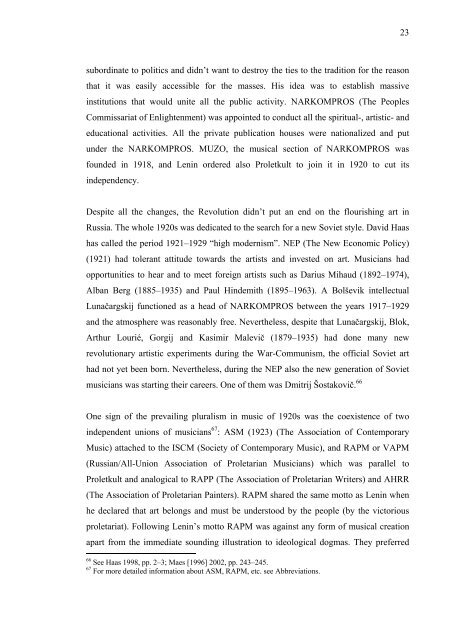Boris Asaf'ev and the Soviet Musicology - E-thesis
Boris Asaf'ev and the Soviet Musicology - E-thesis
Boris Asaf'ev and the Soviet Musicology - E-thesis
Create successful ePaper yourself
Turn your PDF publications into a flip-book with our unique Google optimized e-Paper software.
subordinate to politics <strong>and</strong> didn’t want to destroy <strong>the</strong> ties to <strong>the</strong> tradition for <strong>the</strong> reason<br />
that it was easily accessible for <strong>the</strong> masses. His idea was to establish massive<br />
institutions that would unite all <strong>the</strong> public activity. NARKOMPROS (The Peoples<br />
Commissariat of Enlightenment) was appointed to conduct all <strong>the</strong> spiritual-, artistic- <strong>and</strong><br />
educational activities. All <strong>the</strong> private publication houses were nationalized <strong>and</strong> put<br />
under <strong>the</strong> NARKOMPROS. MUZO, <strong>the</strong> musical section of NARKOMPROS was<br />
founded in 1918, <strong>and</strong> Lenin ordered also Proletkult to join it in 1920 to cut its<br />
independency.<br />
Despite all <strong>the</strong> changes, <strong>the</strong> Revolution didn’t put an end on <strong>the</strong> flourishing art in<br />
Russia. The whole 1920s was dedicated to <strong>the</strong> search for a new <strong>Soviet</strong> style. David Haas<br />
has called <strong>the</strong> period 1921–1929 “high modernism”. NEP (The New Economic Policy)<br />
(1921) had tolerant attitude towards <strong>the</strong> artists <strong>and</strong> invested on art. Musicians had<br />
opportunities to hear <strong>and</strong> to meet foreign artists such as Darius Mihaud (1892–1974),<br />
Alban Berg (1885–1935) <strong>and</strong> Paul Hindemith (1895–1963). A Bolševik intellectual<br />
Lunačargskij functioned as a head of NARKOMPROS between <strong>the</strong> years 1917–1929<br />
<strong>and</strong> <strong>the</strong> atmosphere was reasonably free. Never<strong>the</strong>less, despite that Lunačargskij, Blok,<br />
Arthur Lourié, Gorgij <strong>and</strong> Kasimir Malevič (1879–1935) had done many new<br />
revolutionary artistic experiments during <strong>the</strong> War-Communism, <strong>the</strong> official <strong>Soviet</strong> art<br />
had not yet been born. Never<strong>the</strong>less, during <strong>the</strong> NEP also <strong>the</strong> new generation of <strong>Soviet</strong><br />
musicians was starting <strong>the</strong>ir careers. One of <strong>the</strong>m was Dmitrij Šostakovič. 66<br />
One sign of <strong>the</strong> prevailing pluralism in music of 1920s was <strong>the</strong> coexistence of two<br />
independent unions of musicians 67 : ASM (1923) (The Association of Contemporary<br />
Music) attached to <strong>the</strong> ISCM (Society of Contemporary Music), <strong>and</strong> RAPM or VAPM<br />
(Russian/All-Union Association of Proletarian Musicians) which was parallel to<br />
Proletkult <strong>and</strong> analogical to RAPP (The Association of Proletarian Writers) <strong>and</strong> AHRR<br />
(The Association of Proletarian Painters). RAPM shared <strong>the</strong> same motto as Lenin when<br />
he declared that art belongs <strong>and</strong> must be understood by <strong>the</strong> people (by <strong>the</strong> victorious<br />
proletariat). Following Lenin’s motto RAPM was against any form of musical creation<br />
apart from <strong>the</strong> immediate sounding illustration to ideological dogmas. They preferred<br />
66 See Haas 1998, pp. 2–3; Maes [1996] 2002, pp. 243–245.<br />
67 For more detailed information about ASM, RAPM, etc. see Abbreviations.<br />
23

















